| |
| |
Photographer,
Location, Date |
Larger images |
Comments |
|
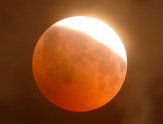
|
William
Chin,
Kuala Lumpur, Malaysia.
Aug. 17, 2008 |
#1,
#2 |
Unbelieved
to see the red color from the lunar dark side. Taken using
mod 350D + 80mm APO f/7 telescope. |
|
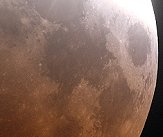

|
Anthony
Ayiomamitis,
Northeastern outskirts of Athens, Greece.
Aug. 16, 2008 |
#1,
#2, more |
Dr
Phillips, The year's fourth eclipse and second lunar eclipse
went out with a bang, for Luna put on an impressive display
during the course of approximately three hours involving
changes in phase, intensity and colouration. It is most
unfortunate that a good portion of western Europe was overcast
with heavy clouds or rains. In spite of the fact that the
depth of the partial eclipse was 81%, a hint of red was
visible in the eclipsed disk well before maximum totality
and when the disk was only 50% within the umbral shadow.
At maximum, the eclipsed disk was quite dark with only a
trace of light and, as indicated by the attached photo at
maximum, a long exposure (3.2 seconds at ISO 200) was required.
Please find attached two sample results (with more on the
way). The first image is the partial totality at maximum
and which required a 3.2" exposure. The second attachment
is the impressive umbral shadow which often is overlooked
when presenting lunar eclipse images and which illustrates
the umbral cone in action. Further details in relation to
these images are available at http://www.perseus.gr/Astro-Eclipses-2008-08-16.htm
and http://www.perseus.gr/Astro-Eclipses-2008-08-16b.htm
. It is unfortunate that we must wait nearly six months
for the next eclipse and whose path of annularity is in
Indonesia. Clear skies and best wishes from Greece! Anthony.
|
|
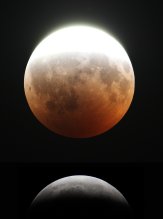
|
Elias Chasiotis,
Markopoulo, Greece.
Aug. 16, 2008 |
#1,
#2, #3 |
The fact that most of the moon was covered by earth's umbra gave the impression of a near total lunar eclipse. Just some minutes after maximum, a star appeared from the eclipsed limb.
William Optics Zenithstar 105, Canon 450D (Xsi).
|
|
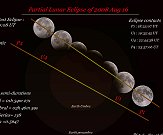
|
Siamak
Sabet,
Tehran, Iran
Aug. 17, 2008 |
#1, |
Photo details:
Canon EOS 350D digital camera
Iso: 100
Tel: 70mm acro
Exposure Time: 1/250S
|
|
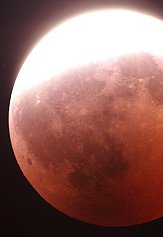
|
Albert Engert,
Uengershausen,BY, Germany
Aug. 16, 2008 |
#1,
more |
Lunar Eclipse from Uengershausen In Bavarian Germany. Photo details: Canon 450d ASA 100 15sec. 200/1000 Newton.
|
|

|
Robert Hoetink,
Enschede
The Netherlands
Aug. 16, 2008 |
#1,
#2, #3,
more |
To be honest, it wasn't quiet as spectacular because it was only 81 %. The most exiting thing seen from The Netherlands was, that at moonrise he showed up above the horizon orange coloured, and 2 hours later it was orange again. From orange to orange I would call these to combined photo's. Nikon D200, 300 mm. lens
|
more
images: from
Mustafa Erol of Antalya, Turkey; from
Pavol Rapavy of Rimavska Sobota, Slovakia; from
Saied Bahrami Nezhad of Shahzadeh garden in Mahan, Kerman,
Iran; from
Jacob Kuiper of Heesch, The Netherlands; from
Helio C. Vital of Rio de Janeiro, Brazil; from
Sandeep of Singapore; from
Willian Souza of Sao Paulo, Brazil; from
SPACE c b devgun of New Delhi, India; from
Tahir Sisman of Kocaeli, Turkey
|
|